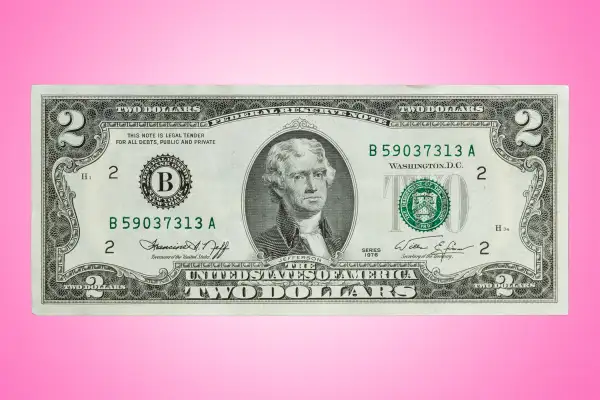America’s Very Brief Love Affair With the $2 Bill

The poor $2 bill.
For as long as anybody can remember it’s been the Edsel of American currency. The New Coke. The Rodney Dangerfield.
But 40 years ago this month, all that seemed about to change.
In April 1976, as the U.S. prepared to mark the bicentennial of the Declaration of Independence, a brand-new two arrived to join the celebration.
President Gerald R. Ford accepted the first of the redesigned bills in a White House ceremony, trading his Treasury secretary a pair of singles in return. The president said he hoped it would become a “popular item.”
Ford had every reason to hope. The government had already printed 225 million of the things, with another 175 million due before the year’s end. If they didn’t go over with the public, and fast, they were going to take up a lot of precious vault space.
The president may also have had his doubts. Earlier attempts to sell the $2 bill to the American people—including a 1925 PR campaign by the Federal Bureau of Efficiency (!)—had gone nowhere. The Treasury finally gave up and dumped the denomination in 1966.
Unlucky and unloved
How a perfectly innocent piece of paper—one that’s actually worth money—could be so unloved has been a mystery for generations. Most likely it was a combination of factors. Superstitious gamblers believed $2 bills were unlucky—again, for reasons unknown. Cashiers and bank tellers considered them a nuisance because cash trays usually didn’t have a place for them. And while twos had their fans among collectors, the public in general never saw the point.
But to the government, the bill seemed like a panacea for its overworked printing presses. A $2 bill cost no more to print than a $1 bill, and by making more of the former and fewer of the latter, the Treasury Department expected to save millions of dollars a year.
The patriotic hoopla of the bicentennial seemed to offer a perfect excuse to bring the bill back. The latest version featured none other than Declaration of Independence author Thomas Jefferson on the front and a group portrait of the declaration’s signers on the back.
When the new two was released to the public on April 13, 1976, Jefferson’s 233rd birthday, it seemed as if the “deuce” might finally have its day.
Like a bank run, with hotcakes
Across the country, tens of thousands of Americans reportedly lined up to buy them. Boston’s largest bank said the bills went like—what else?—hotcakes. A Houston banker compared it to a bank run. Similar reports came in from Chicago, New York, Philadelphia, and Washington, D.C.
“Big Spenders Buying Up $2 Bills,” the headline in one Michigan newspaper exclaimed. A Pennsylvania paper put it in groovier terms: “Two-Dollar Bill Turns People ‘On.’”
Buyers not only mobbed the banks but local post offices, as well. Many wanted to have their bills postmarked, to prove they got them on the first day of issue. A Virginia postmaster said his clerks stamped 25,000 bills that day and likened the scene to a circus.
What happened after that? Well, not much. The initial enthusiasm wore off in a matter of days. Before the week was out, one Massachusetts newspaper would headline its story “Rush for $2 Bills Tapering Off.”
Trouble was, gamblers still considered the $2 bill unlucky, cashiers still found it annoying, and the majority of the American people remained indifferent. Like so many of its predecessors, the new, improved $2 bill of 1976 was soon written off as a failure.
Another day, another dollar
In fact, the two was now so tainted that three years later, when the Treasury revisited the costly problem of printing and replacing so many $1 bills, few would have dared suggest it as a solution. So the Treasury instead put its money on a shiny new $1 coin bearing the likeness of the women’s rights activist Susan B. Anthony. It turned out to be even less popular than the $2 bill, possibly the biggest flop in the history of American money.
VOTE: Who Should Be the First Woman On a Modern Dollar Bill?
Meanwhile, the $2 bill didn’t go away completely. People saved them, and millions are still out there somewhere, in safe-deposit boxes, sock drawers, and family Bibles. Despite what many collectors hoped, they never went up in value. But at least they're still worth $2.
If you have a $2 bill stashed away, give it a look. Odds are very good it’s dated 1976—a souvenir of what might have been.
